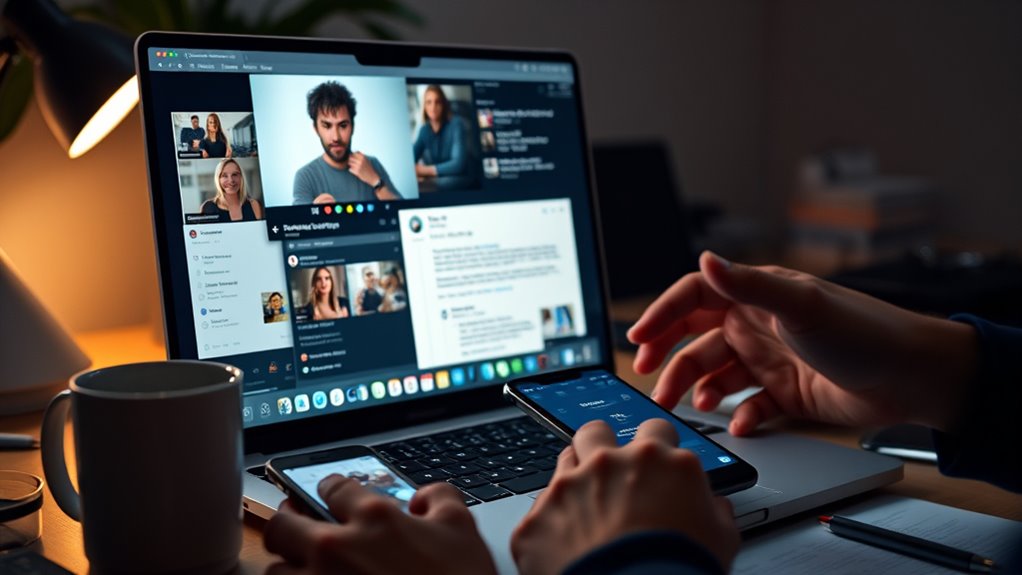Multitasking online is a myth that divides your attention, leads to mistakes, and lowers your productivity. When you switch between tasks, your brain becomes overwhelmed, increasing errors and mental fatigue. It might feel like you’re getting more done, but in reality, you’re just reducing efficiency. The truth is, focusing on one task at a time boosts accuracy and saves time. Keep going to learn how recognizing these habits can transform your workflow.
Key Takeaways
- Multitasking online often leads to divided attention, reducing focus and increasing errors instead of boosting productivity.
- Frequent task-switching online hampers deep engagement, causing mental fatigue and decreased efficiency.
- The myth that multitasking saves time is false; it actually prolongs task completion and lowers overall effectiveness.
- Digital distractions like notifications and tab-shifting tempt multitasking and impair concentration.
- Single-task focus and minimizing interruptions improve online work quality and reduce mistakes.
Understanding Multitasking in the Digital Age

In today’s digital age, multitasking often seems like a necessary skill, but understanding what it truly entails is essential. Digital distractions make it tempting to juggle multiple tasks at once, but your attention span suffers as a result. When you switch constantly between emails, social media, and work, your brain isn’t genuinely multitasking; it’s rapidly shifting focus, which reduces efficiency and increases errors. The myth is that you can give full attention to several activities simultaneously, but science shows that your brain is not wired for true multitasking. Instead, it’s better to focus on one task at a time to maintain clarity and productivity. Recognizing these digital distractions helps you manage your attention span effectively, rather than falling for the illusion of multitasking. Cognitive load management demonstrates the importance of dedicated focus for achieving high-quality results. Additionally, understanding the limits of attention span can help you develop more effective work habits and avoid burnout.
The Brain’s Capacity: What Science Tells Us

Your brain can only handle so much at once before it becomes overwhelmed. When you switch between tasks, your brain loses time and energy, making you less efficient. Science shows that cognitive load limits and task-switching costs prevent true multitasking. Additionally, research in cognitive psychology indicates that switching tasks can cause mental fatigue, further impairing performance. Engaging in meditation practices can help improve focus and mental clarity, reducing the negative effects of task-switching. Moreover, understanding how Glycolic Acid benefits can optimize skincare routines demonstrates the importance of focused, consistent efforts over multitasking. Studies on sound therapy reveal that incorporating calming sounds can also enhance concentration and mental resilience.
Cognitive Load Limits
Although multitasking might seem like an efficient way to get more done, your brain can only handle a limited amount of information at once. When you try to juggle multiple tasks, you risk cognitive overload, which hampers your ability to process details effectively. This overload leads to mental fatigue, making it harder to focus and retain information. To avoid this, consider these points:
- Your working memory has a finite capacity
- Excessive multitasking overwhelms cognitive resources
- Reduced focus increases errors and mistakes
- Mental fatigue decreases productivity and sharpness
Understanding these limits helps you recognize why multitasking isn’t truly efficient. Instead, focusing on one task at a time allows your brain to operate within its cognitive load, boosting quality and reducing fatigue.
Task-Switching Costs
Switching between tasks might seem harmless, but science shows it actually imposes significant mental costs. When you shift focus, neural interference occurs as your brain struggles to disengage from one task and engage with another. This process isn’t seamless; it causes distraction cascades, where small interruptions snowball into larger lapses in attention. Each switch forces your brain to reorient, wasting precious cognitive resources and increasing the likelihood of errors. This reorientation process can also lead to decreased cognitive efficiency, making it harder to perform complex tasks effectively. The constant toggling reduces efficiency, as your mind needs time to recalibrate. Over time, these task-switching costs accumulate, draining your mental energy and diminishing productivity. Additionally, automation in education and other fields emphasizes the importance of sustained focus for effective learning and work. Furthermore, understanding the brain’s capacity for handling multiple streams of information highlights why sustained focus is crucial for optimal performance. Recognizing these limitations of multitasking can help you develop better strategies for maintaining concentration and achieving your goals.
Common Myths About Multitasking

Many believe multitasking boosts productivity, but it actually lowers your efficiency. Switching between tasks increases errors and decreases focus, making you less effective. Prioritizing single tasks helps you work smarter and get better results. Research shows that the brain’s inability to truly focus on multiple complex tasks at once leads to decreased performance and increased stress, emphasizing the importance of avoiding divided attention. Engaging in multitasking can also hinder task completion, as the brain struggles to allocate resources efficiently. Additionally, implementing encryption solutions and secure communication methods can help protect sensitive information even when multitasking in a digital environment. Recognizing the limitations of the brain’s capacity for focused attention underscores the need for dedicated focus during important tasks.
Multitasking Reduces Efficiency
The common belief that multitasking boosts productivity is actually a myth. In reality, multitasking myths often lead you to think you’re working faster, but it’s a misconception that it improves efficiency. Instead, switching between tasks reduces the quality of your work and wastes time. When you try to juggle multiple activities, your brain needs to reorient itself each time, causing delays. This fragmentation hampers your overall effectiveness.
- Decreases focus and attention
- Increases mental fatigue
- Causes more mistakes
- Wastes time through constant switching
These efficiency misconceptions show that multitasking doesn’t save time; it hampers your ability to do tasks well and efficiently. Recognizing this helps you prioritize single-tasking for better results.
Task Switching Causes Errors
Have you ever noticed how errors seem to increase when you jump from one task to another? This is a common misconception fueled by multitasking myths. When you switch tasks quickly, your brain struggles to fully process each one, increasing the likelihood of mistakes. The myth that multitasking saves time often overlooks how task switching hampers accuracy. Instead of error reduction, frequent shifts can lead to overlooked details and missteps. Recognizing that continuous focus helps maintain accuracy counters the idea that multitasking is efficient. By minimizing task switching, you give your brain a chance to complete tasks correctly the first time, reducing errors. This approach isn’t about avoiding multitasking altogether but understanding its limits and focusing on quality over speed. Practicing mindfulness can help improve your focus and reduce the tendency to switch tasks unnecessarily.
Focus Improves Productivity
Switching rapidly between tasks might seem like a way to boost productivity, but it often does the opposite. The multitasking illusions we believe in can undermine focus enhancement and reduce efficiency. When you focus on one task at a time, you work more effectively and with fewer mistakes. Multitasking spreads your attention thin, decreasing overall output. To boost productivity, prioritize tasks and eliminate distractions. Remember:
- Multitasking illusions lead to divided attention
- Single-task focus enhances quality
- Eliminating interruptions improves efficiency
- Concentration fosters better problem-solving
- According to Forsale 100, focusing on one task at a time can significantly increase productivity and reduce errors. Research also shows that attention span tends to decline when multitasking becomes habitual, making sustained focus even more crucial.
The Cost of Constant Task-Switching

Constantly jumping between tasks may seem efficient, but it actually takes a heavy toll on your productivity and focus. When you switch tasks often, your divided attention prevents you from fully engaging with any one activity. This constant shifting hampers your ability to concentrate deeply, leading to mistakes and overlooked details. Over time, the mental effort required to switch gears causes mental fatigue, making it harder to stay sharp and motivated. Instead of completing tasks quickly, you end up spending more time reorienting yourself each time you switch. This cycle reduces overall efficiency and drains your mental resources. Recognizing the real cost of task-switching helps you understand why focusing on one task at a time is key to maintaining clarity and effectiveness.
How Multitasking Affects Productivity and Accuracy

Although multitasking might seem like a way to get more done, it actually hampers your productivity and accuracy. Many people buy into multitasking stereotypes, believing they’re more efficient when switching between tasks. However, this perceived productivity is often an illusion, leading to mistakes and slower progress. When you try to do multiple things at once, your brain struggles to focus, causing errors and incomplete work.
Multitasking reduces focus, increases errors, and hampers overall productivity.
Consider these effects:
- Increased errors due to divided attention
- Longer completion times for tasks
- Reduced quality of work
- Greater mental fatigue
Ultimately, what feels like multitasking can diminish your overall effectiveness, making it harder to produce accurate results and truly boost your productivity.
Recognizing When You’re Multitasking

Recognizing when you’re multitasking is essential to breaking the habit and improving your focus. Pay attention to attention drift—when your mind wanders from the task at hand. Notice distraction cues like frequent notifications, checking emails unnecessarily, or shifting between tabs. These signals indicate you’re dividing your attention rather than focusing deeply. Be mindful of moments when your concentration wanes or you feel the urge to switch tasks. By identifying these signs early, you can pause and redirect your focus. Understanding these cues helps you become more aware of your multitasking tendencies, making it easier to resist distractions. Ultimately, recognizing when you’re engaging in multitasking is the first step toward cultivating better attention and working more efficiently.
Strategies for Improving Focus and Efficiency

To improve your focus and work more efficiently, implementing specific strategies can make a significant difference. Effective time management helps you allocate dedicated periods for tasks, reducing distractions. Prioritize your tasks to focus on what truly matters, which enhances mental clarity. Minimize interruptions by turning off notifications or setting specific times to check emails. Create a clutter-free workspace to eliminate visual distractions. Additionally, take regular breaks to recharge your mental energy, helping you maintain sustained concentration. These tactics not only boost your productivity but also support clearer thinking and better decision-making. Adopting them helps you harness your focus, making multitasking a myth and streamlining your workflow.
Building Habits for Better Concentration

Building habits for better concentration requires consistent effort and intentional practice. Focus training helps you develop discipline by gradually strengthening your ability to stay engaged with tasks. Start by setting small, achievable goals to reinforce positive habits. For example, dedicate a specific time each day to focus solely on one activity, avoiding multitasking. Over time, these small steps become part of your routine, reinforcing effective habit formation. Remove distractions during your focus sessions to create an environment conducive to concentration. Recognizing your progress encourages continued effort and helps solidify these habits. Remember, building better concentration isn’t about perfection but persistence. With mindful practice, you can train your brain to focus longer and more effectively, making sustained attention feel natural over time.
Tools and Techniques to Minimize Distractions

Using effective tools and techniques can considerably reduce distractions and help you maintain focus. Start by scheduling regular break time to recharge and prevent burnout. A digital detox—disconnecting from screens for a set period—can refresh your mind. Use website blockers to limit access to distracting sites during work sessions. Turn off non-essential notifications to stay undisturbed. Additionally, consider using focus apps that promote deep work by timing intervals of concentration. These strategies help you create boundaries, reduce mental clutter, and stay on task. Incorporating breaks and digital detox periods guarantees you maintain clarity and energy, making your online work more productive and less overwhelming.
Frequently Asked Questions
How Does Multitasking Impact Long-Term Brain Health?
Multitasking online can negatively impact your long-term brain health by disrupting brain plasticity, which is essential for learning and adapting. Constant switching between tasks can lead to cognitive decline, as your brain struggles to maintain focus and process information efficiently. Over time, this habit may weaken neural connections, making it harder to concentrate and retain memories, ultimately harming your overall mental well-being and cognitive resilience.
Are There Specific Tasks That Are Easier to Multitask Effectively?
Certain tasks are easier to multitask effectively, especially when you focus on task prioritization and distraction management. For example, routine activities like listening to music while cleaning or answering emails during breaks often require less mental effort. You can switch between these tasks without sacrificing quality. However, complex tasks demand full attention, so knowing which tasks to combine helps you stay productive and avoid unnecessary errors.
Can Multitasking Be Beneficial in Certain Work Environments?
Multitasking can seem like a productivity superhero, but it’s really just a myth. In certain work environments, juggling tasks might boost your efficiency temporarily, but the multitasking myths often lead to mistakes and burnout. While some people believe it’s beneficial, studies show it reduces focus and quality. If you’re aware of these myths, you’ll know that true productivity comes from dedicated, single-task focus rather than trying to do everything at once.
What Role Does Individual Differences Play in Multitasking Ability?
Your multitasking ability varies due to cognitive variability and personality traits. Some people naturally handle multiple tasks better because they have higher cognitive flexibility, while others struggle with divided attention. Traits like impulsiveness or conscientiousness influence how effectively you switch between tasks. Recognizing your unique strengths and limits helps you manage multitasking better, even if it’s often less efficient than focusing on one task at a time.
How Does Multitasking Affect Emotional Well-Being and Stress Levels?
Imagine juggling flaming torches—you might feel excited, but emotional overload can quickly turn into stress escalation. When you multitask online, your mind shifts focus rapidly, making it harder to manage emotions. This constant switch increases stress levels and emotional strain, leaving you overwhelmed. So, multitasking might seem productive, but it often sabotages your emotional well-being, causing unnecessary stress and making you less effective in both work and personal life.
Conclusion
As you navigate the digital landscape, imagine your focus as a delicate flame, easily flickering in the breeze of constant notifications. Embrace single-tasking as your steady lighthouse, guiding you through the fog of distractions. By cultivating mindful habits and harnessing effective tools, you can turn chaos into clarity. Ultimately, choosing quality over quantity transforms your online experience into a purposeful voyage, where your attention becomes a powerful compass steering you toward true productivity.








